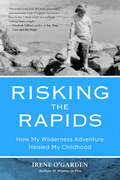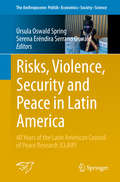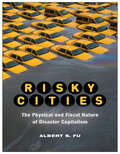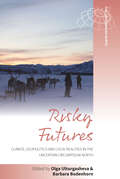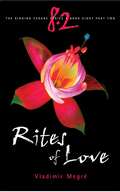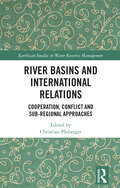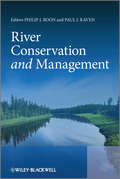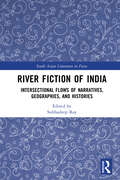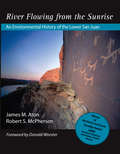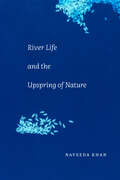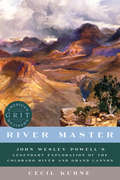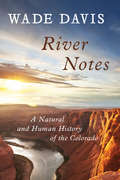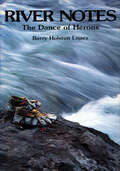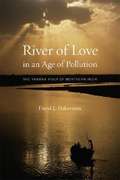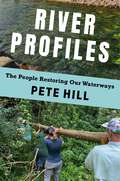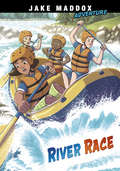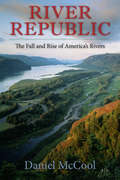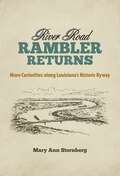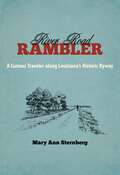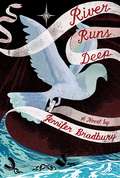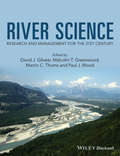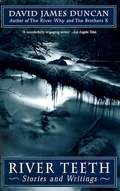- Table View
- List View
Risking the Rapids: How My Wilderness Adventure Healed My Childhood
by Irene O'GardenA memoir of a dysfunctional, grieving family reuniting for a turbulent rafting trip, from an author with a “captivating talent for wonder and marvel.”?Elizabeth Gilbert, author of Eat, Pray, LoveAfter the sudden death of Irene O’Garden’s older brother, she and her family decide to seek closure together by taking a journey through the remotest spot in Montana. The story of their harrowing trip on the river is intertwined here with the author’s account of growing up with her six siblings in a clashing Catholic family under the shadow of alcoholism.O’Garden’s father, a local TV personality in Minnesota, leaves his cheery public persona behind when he comes home and starts drinking martinis with his undemonstrative, icy-hearted wife. The children vary in their responses to profound anxiety sown in an atmosphere of neglect, psychological abuse, and rigid religiosity: One brother bites his fingers to gangrene. One relentlessly bullies the author, who begins overeating compulsively. One severs all ties with the family. Meanwhile, in the present, danger mounts as well on the raft trip, when unusual river conditions swell and speed the waters. Both stories build with escalating intensity to excruciating climaxes.Some memoirs shock. Some entertain. Some take us places we’re afraid to go. A rare few move us. Once in a blue moon, a book does it all. This is Risking the Rapids.“Enthralling.” —Malachy McCourt, author of A Monk Swimming“A deep and powerful memoir.” —Martha Beck, author of Finding Your Own North Star“Breathtaking . . . O’Garden adds a thoroughly welcome voice to the rich vein of American literature on the singular healing powers of wilderness.”? Florence Williams, award-winning author of The Nature Fix
Risks, Violence, Security and Peace in Latin America: 40 Years of the Latin American Council of Peace Research (CLAIP) (The Anthropocene: Politik—Economics—Society—Science #24)
by Úrsula Oswald Spring Serena Eréndira Serrano OswaldThis book analyses the war against drugs, violence in streets, schools and families, and mining conflicts in Latin America. It examines the nonviolent negotiations, human rights, peacebuilding and education, explores security in cyberspace and proposes to overcome xenophobia, white supremacy, sexism, and homophobia, where social inequality increases injustice and violence. During the past 40 years of the Latin American Council for Peace Research (CLAIP) regional conditions have worsened. Environmental justice was crucial in the recent peace process in Colombia, but also in other countries, where indigenous people are losing their livelihood and identity. Since the end of the cold war, capitalism aggravated the life conditions of poor people. The neoliberal dismantling of the State reduced their rights and wellbeing in favour of enterprises. Youth are not only the most exposed to violence, but represent also the future for a different management of human relations and nature.
Risky Cities: The Physical and Fiscal Nature of Disaster Capitalism (Nature, Society, and Culture)
by Albert S. FuOver half the world’s population lives in urban regions, and increasingly disasters are of great concern to city dwellers, policymakers, and builders. However, disaster risk is also of great interest to corporations, financiers, and investors. Risky Cities is a critical examination of global urban development, capitalism, and its relationship with environmental hazards. It is about how cities live and profit from the threat of sinkholes, garbage, and fire. Risky Cities is not simply about post-catastrophe profiteering. This book focuses on the way in which disaster capitalism has figured out ways to commodify environmental bads and manage risks. Notably, capitalist city-building results in the physical transformation of nature. This necessitates risk management strategies –such as insurance, environmental assessments, and technocratic mitigation plans. As such capitalists redistribute risk relying on short-term fixes to disaster risk rather than address long-term vulnerabilities.
Risky Futures: Climate, Geopolitics and Local Realities in the Uncertain Circumpolar North (Studies in the Circumpolar North #6)
by Olga Ulturgasheva Barbara BodenhornThe volume examines complex intersections of environmental conditions, geopolitical tensions and local innovative reactions characterising ‘the Arctic’ in the early twenty-first century. What happens in the region (such as permafrost thaw or methane release) not only sweeps rapidly through local ecosystems but also has profound global implications. Bringing together a unique combination of authors who are local practitioners, indigenous scholars and international researchers, the book provides nuanced views of the social consequences of climate change and environmental risks across human and non-human realms.
Rites of Love (The Ringing Cedars Series #8, Part #2)
by Vladimir Megré John Woodsworth Leonid SharashkinThis book is a call to research, to becoming aware of the Divine programme.
River
by Debby AtwellWith direct language and colorful paintings, Debby Atwell relates the changes that occur through the centuries along a riverbank, from the arrival of the first humans to the coming of the first settlers, from the industrial revolution to the present day. As the river flows the country grows and progresses along its banks-sometimes for better and sometimes for worse. When overuse and carelessness finally take their toll, the river's natural beauty and resources are compromised. Can the river thrive permeated by pollution and waste? Travel downstream through time as Atwell's evocative text and narrative paintings enliven the beauty and spirit of the river, revealing life as it was and telling how it has evolved.
River Basins and International Relations: Cooperation, Conflict and Sub-Regional Approaches (Earthscan Studies in Water Resource Management)
by Christian PlobergerThis book argues that river basins represent a particular structural setting in international relations with the potential for generating a dynamic of cooperation among the involved countries. The volume applies the concept of regional cooperation to international river basins to highlight their relevance as a particular space in international relations, emphasizing both the inter-connectivity and transnationalism of international river basins. It addresses the challenges related to resource distribution between up- and down-stream countries, showcasing a variety of examples of cooperation and conflictual relations within various international river basins. Case studies are drawn from across the globe and include the Mekong, the Indus, the Euphrates-Tigris and the Danube international river basins. Each chapter outlines the different aspects which support or undermine cooperation in each case, taking into consideration key areas surrounding resource sharing, national development, environmental considerations and national security. This book will be of great interest to students and scholars with an interest in international river basins, regional cooperation, water resource competition, international relations and environmental politics.
River Conservation and Management
by Paul Raven Philip BoonThis book is intended for those with an academic, scientific and practical interest in river conservation and management. It provides an overview of how changes in legislation, policies, institutional responsibilities, science, technology, practical techniques and public perception have influenced how rivers have been managed over the past 20 years and the challenges that lie ahead during the next 20 years.The book is based on the international conference River Conservation and Management:20 Years On held at York. Thirty-one chapters, with contributions from North and South America, Europe, Asia and Australasia provide a wide-ranging perspective on this complex but profoundly important subject. Following an introduction that chronicles the most important contextual changes, the book is organized into four broad topics:Catchment management, ecosystem integrity and the threats to river ecosystems - this covers progress on understanding and addressing the pressures affecting rivers, many of which will be amplified by climate change and increasing human demands for water; Methods and approaches - illustrating some recent techniques that have been developed to assess condition and conservation status across different types of river; Recovery and rehabilitation - providing an insight into the principles, practice, public involvement and institutional networks that support and make improvements to modified river reaches; Integrating nature conservation into wider river management -demonstrating the importance of integrated planning, involvement of local communities and the use of adaptive management in achieving multiple environmental and economic benefits along rivers used for different purposes. The final chapter discusses the challenges faced in dealing with an uncertain future.More than 1200 different references and numerous web-site citations provide the reader with an invaluable source of knowledge on the subject area.
River Fiction of India: Intersectional Flows of Narratives, Geographies, and Histories (South Asian Literature in Focus)
by Subhadeep RayThis book establishes river fiction as an identifiable genre-fiction. It argues that rivers and riverbeds—through myths and legends, ecological and environmental concerns, geographical and historical realities, politics and economics around them—can provide an underlying framework to understand Indian prose fiction. With essays on river fiction across India, the volume presents a new way of understanding and reading South Asian literature. The volume will be of great interest to scholars and researchers of literature and literary criticism and South Asian studies.
River Flowing From The Sunrise: An Environmental History of the Lower San Juan
by James M Aton Robert McPhersonThe authors recount twelve millennia of history along the lower San Juan River, much of it the story of mostly unsuccessful human attempts to make a living from the river's arid and fickle environment. From the Anasazi to government dam builders, from Navajo to Mormon herders and farmers, from scientific explorers to busted miners, the San Juan has attracted more attention and fueled more hopes than such a remote, unpromising, and muddy stream would seem to merit.
River Flowing from the Sunrise
by Robert S. Mcpherson James M. AtonThe authors recount twelve millennia of history along the lower San Juan River, much of it the story of mostly unsuccessful human attempts to make a living from the river's arid and fickle environment. From the Anasazi to government dam builders, from Navajo to Mormon herders and farmers, from scientific explorers to busted miners, the San Juan has attracted more attention and fuelled more hopes than such a remote, unpromising, and muddy stream would seem to merit.
River Life and the Upspring of Nature
by Naveeda KhanIn River Life and the Upspring of Nature Naveeda Khan examines the relationship between nature and culture through the study of the everyday existence of chauras, the people who live on the chars (sandbars) within the Jamuna River in Bangladesh. Nature is a primary force at play within this existence as chauras live itinerantly and in flux with the ever-changing river flows; where land is here today and gone tomorrow, the quality of life itself is intertwined with this mutability. Given this centrality of nature to chaura life, Khan contends that we must think of nature not simply as the physical landscape and the plants and animals that live within it but as that which exists within the social and at the level of cognition, the unconscious, intuition, memory, embodiment, and symbolization. By showing how the alluvial flood plains configure chaura life, Khan shows how nature can both give rise to and inhabit social, political, and spiritual forms of life.
River Master: John Wesley Powell's Legendary Exploration Of The Colorado River And Grand Canyon (American Grit #0)
by Cecil KuhneExperience John Powel's now-famous expedition through the Grand Canyon In 1869, Civil War veteran and amputee Major John Wesley Powell led an expedition down the uncharted Colorado River through the then-nameless Grand Canyon. This is the story of what started as a geological survey, but ended in danger, chaos, and blood. The men were inexperienced and ill-equipped, and they faced unimaginable peril. Along the way there was death, mutiny, and abject terror, but Powell persevered and produced a masterwork of adventure writing still held in the highest regard by the boatmen who follow his course today. With never-before-used primary sources and firsthand experience navigating Powell’s legendary route, Cecil Kuhne brings this remarkable chapter of frontier history to life. The American Grit series brings you true tales of endurance, survival, and ingenuity from the annals of American history. These books focus on the trials of remarkable individuals with an emphasis on rich primary source material and artwork.
River Notes: A Natural and Human History of the Colorado
by Wade DavisPlugged by no fewer than twenty-five dams, the Colorado is the world's most regulated river drainage. The Colorado River provides most of the water supply of Las Vegas, Tucson, and San Diego, and much of the power and water of Los Angeles and Phoenix, cities that are home to more than 25 million people. If it ceased flowing, the water held in its reservoirs might hold out for three to four years, but after that it would be necessary to abandon most of southern California and Arizona, and much of Colorado, New Mexico, Utah and Wyoming. For the entire American Southwest the Colorado is indeed the river of life, which makes it all the more tragic and ironic that by the time it approaches its final destination, it has been reduced to a shadow upon the sand, its delta dry and deserted, its flow a toxic trickle seeping into the sea. In this remarkable blend of history, science, and personal observation, acclaimed author Wade Davis tells the story of America's Nile, how it once flowed freely and how human intervention has left it near exhaustion, altering the water temperature, volume, local species, and shoreline of the river Theodore Roosevelt once urged us to "leave it as it is." Yet despite a century of human interference, Davis writes, the splendor of the Colorado lives on in the river's remaining wild rapids, quiet pools, and sweeping canyons. The story of the Colorado River is the human quest for progress and its inevitable if unintended effects--and an opportunity to learn from past mistakes and foster the rebirth of America's most iconic waterway. A beautifully told story of historical adventure and natural beauty, River Notes is a fascinating journey down the river and through mankind's complicated and destructive relationship with one of its greatest natural resources.
River Notes: The Dance of Herons
by Barry Holstun LopezAn acclaimed nature writer evokes and celebrates the forces, settings, rituals, movements, and imperatives of a river, as it calls us back to unity with the natural world.
River Of Love In An Age Of Pollution: The Yamuna River Of Northern India
by David L. HabermanCelebrated as an aquatic form of divinity for thousands of years, the Yamuna is one of India's most sacred rivers. A prominent feature of north Indian culture, the Yamuna is conceptualized as a goddess flowing with liquid love -- yet today it is severely polluted, the victim of fast-paced industrial development. <P> This fascinating and beautifully written book investigates the stories, theology, and religious practices connected with this river goddess collected from texts written over several millennia, as well as from talks with pilgrims, priests, and worshippers who frequent the pilgrimage sites and temples located on her banks. <P> David L. Haberman offers a detailed analysis of the environmental condition of the river and examines how religious practices are affected by its current pollution. He introduces Indian river environmentalism, a form of activism that is different in many ways from its western counterpart. River of Love in an Age of Pollution concludes with a consideration of the broader implications of the Yamuna's plight and its effect on worldwide efforts to preserve our environment.
River Otter (Nature's Children)
by Laima DingwallDid you know... that river otters are considered the clowns of the animal kingdom; that otters do not hibernate but will play, swim and live out their winters under the ice; and that otters use tools to eat their food. Find out lots of exciting facts about this wonderful creature.
River Profiles: The People Restoring Our Waterways
by Pete HillCenturies of mismanagement and destructive development have gravely harmed American waterways, with significant consequences for the ecosystems and communities built around them. But a range of passionate and committed people have stepped up to restore streams and rivers around the United States. A husband-and-wife scientist team in Pennsylvania lead projects to unclog the sediment left by early colonists’ dams. Members of the Tulalip Tribes in western Washington State bring beavers back to headwater streams. A public servant in Milwaukee drives the sewer department to remove concrete channels and reduce flood risk. Community activists in Atlanta push for environmental justice in river restoration.Telling these stories and many more, Pete Hill—a twenty-year veteran of the field of watershed restoration—provides a deep dive into the world of river and stream conservation. He profiles the practitioners, scientists, and activists from all walks of life who take part in restoration efforts, exploring their differing, sometimes controversial approaches. Through their stories, Hill illustrates the challenges and rewards of river restoration and the evolving scientific understanding in the field. Underscoring the need for a variety of strategies adapted to different local contexts, he shows that new ideas have come from a wide range of people—from those operating the machinery to those researching stream ecology—and that Indigenous knowledge offers vital resources. At once personal and learned, insightful and inspiring, this book shines a light on the people working to heal our streams and rivers.
River Race (Jake Maddox Adventure)
by Jake MaddoxNate, Selena, Tyson, and Alicia are ready for summer. But when Nate convinces everyone to join a white water rafting race, the group’s teamwork is put to the test. Will these four friends make it past the finish line? Or will their competitive nature sink their chances?
River Republic: The Fall and Rise of America's Rivers
by Daniel McCoolDaniel McCool not only chronicles the history of water development agencies in America and the way in which special interests have abused rather than preserved the country's rivers, he also narrates the second, brighter act in this ongoing story: the surging, grassroots movement to bring these rivers back to life and ensure they remain pristine for future generations. The culmination of ten years of research and observation, McCool's book confirms the surprising news that America's rivers are indeed returning to a healthier, free-flowing condition. The politics of river restoration demonstrates how strong grassroots movements can challenge entrenched powers and win. Through passion and dedication, ordinary people are reclaiming the American landscape, forming a "river republic" of concerned citizens from all backgrounds and sectors of society. As McCool shows, the history, culture, and fate of America is tied to its rivers, and their restoration is a microcosm mirroring American beliefs, livelihoods, and an increasing awareness of what two hundred years of environmental degradation can do. McCool profiles the individuals he calls "instigators," who initiated the fight for these waterways and, despite enormous odds, have succeeded in the near-impossible task of challenging and changing the status quo. Part I of the volume recounts the history of America's relationship to its rivers; part II describes how and why Americans "parted" them out, destroying their essence and diminishing their value; and part III shows how society can live in harmony with its waterways while restoring their well-being—and, by extension, the well-being of those who depend on them.
River Road Rambler Returns: More Curiosities along Louisiana's Historic Byway
by Mary Ann Sternberg Elizabeth Randall NeelyIn River Road Rambler Returns: More Curiosities along Louisiana’s Historic Byway, Mary Ann Sternberg follows up her successful River Road Rambler with new delightful histories from Louisiana’s most famous route. Her latest explorations include a trip on a towboat as it pushes a fleet of barges down the river; the true story behind the Sunshine Bridge, fondly called the Bridge to Nowhere; a tour of one of the last working sugar mills along the River Road; stories about how two iconic plantation houses were saved; and much more.Well researched and engagingly written, River Road Rambler Returns provides keen observations on unappreciated places and offers rich histories of unusual attractions along the winding road that lines the Mississippi River between New Orleans and Baton Rouge.
River Road Rambler: A Curious Traveler along Louisiana's Historic Byway (Southern Literary Studies)
by Mary Ann SternbergThe River Road between New Orleans and Baton Rouge hosts a fascinating mix of people, traditions, and stories. Author Mary Ann Sternberg has spent over two decades exploring this historic corridor, uncovering its intriguing and often-underappreciated places. In River Road Rambler, she presents fifteen sketches about sites along this scenic route. From familiar stops, such as the National Hansen's Disease Center Museum at Carville and the perique tobacco area of St. James Parish to lesser-known attractions such as Our Lady of Lourdes grotto in the town of Convent and the Colonial Sugars Historic District, Sternberg provides a new perspective on some of the region's most colorful places. While many of these locales remain easily accessible to any River Road rambler, Sternberg also depicts others closed to the public, giving armchair travelers an introduction to these otherwise unreachable attractions. Throughout, Sternberg captures the ambiance of her surroundings with a clear, engaging, and personal examination of the relationships between past and present. In a poignant piece on the garden of "Valcour" Aime, for example, she delves into the history of this lavish, nationally acclaimed planter's garden, established and abandoned in the mid-nineteenth century. Her visit to the now-private and protected site, which has never been altered or replanted, uncovers an extraordinary landscape -- the relic of what Aime created, slowly overwhelmed by nature. These sketches brim with insights and observations about everything from the fire that razed The Cottage plantation to the failed attempts to salvage the reproduction of the seventeenth-century French warship Le Pelican from the bottom of the Mississippi. River Road Rambler links us to both past and present while revealing delightful and unexpected surprises only found along this storied byway.
River Runs Deep
by Jennifer Bradbury<P>When a boy is sent to Mammoth cave to fight a case of consumption, little does he know he'll also be fighting for the lives of a secret community of escaped slaves, who are hidden deep within the cave. <P>Twelve-year-old Elias has consumption, so he is sent to Kentucky's Mammoth Cave--the biggest cave in America--where the cool cave vapors are said to be healing. At first, living in a cave sounds like an adventure, but after a few days, Elias feels more sick of boredom than his illness. <P>So he is thrilled when Stephen, one of the slaves who works in the cave, invites him to walk further through its depths. But there are more than just tunnels and stalagmites waiting to be discovered; there are mysteries hiding around every turn. <P>The truths they conceal are far more stunning than anything Elias could ever have imagined, and he finds himself caught right in the middle of it all--while he's supposed to be resting. But how can he focus on saving his own life when so many others are in danger?
River Science: Research and Management for the 21st Century
by David J. Gilvear Malcolm T. Greenwood Martin C. Thoms Paul J WoodRiver Science is a rapidly developing interdisciplinary field at the interface of the natural sciences, engineering and socio-political sciences. It recognises that the sustainable management of contemporary rivers will increasingly require new ways of characterising them to enable engagement with the diverse range of stakeholders.This volume represents the outcome of research by many of the authors and their colleagues over the last 40 years and demonstrates the integral role that River Science now plays in underpinning our understanding of the functioning of natural ecosystems, and how societal demands and historic changes have affected these systems. The book will inform academics, policy makers and society in general of the benefits of healthy functioning riverine systems, and will increase awareness of the wide range of ecosystem goods and services they provide.
River Teeth: Stories and Writings
by David James DuncanIn his passionate, luminous novels, David James Duncan has won the devotion of countless critics and readers, earning comparisons to Harper Lee, Tom Robbins, and J.D. Salinger, to name just a few. Now Duncan distills his remarkable powers of observation into this unique collection of short stories and essays. At the heart of Duncan's tales are characters undergoing the complex and violent process of transformation, with results both painful and wondrous. Equally affecting are his nonfiction reminiscences, the "river teeth" of the title. He likens his memories to the remains of old-growth trees that fall into Northwestern rivers and are sculpted by time and water. These experiences--shaped by his own river of time--are related with the art and grace of a master storyteller. In River Teeth, a uniquely gifted American writer blends two forms, taking us into the rivers of truth and make-believe, and all that lies in between.
